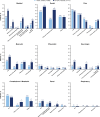Disease burden by ALPL variant number in patients with non-life-threatening hypophosphatasia in the Global HPP Registry
- PMID: 39965917
- PMCID: PMC12015031
- DOI: 10.1136/jmg-2024-110383
Disease burden by ALPL variant number in patients with non-life-threatening hypophosphatasia in the Global HPP Registry
Abstract
Background: Hypophosphatasia (HPP) is a rare metabolic disease caused by autosomal dominant or recessive inheritance of ALPL variants resulting in low alkaline phosphatase activity. The objective of this analysis was to compare HPP disease burden between patients with non-life-threatening disease in the Global HPP Registry who have one ALPL variant versus two or more ALPL variants.
Methods: Patients were included if they had one or more ALPL variants identified through genetic testing and first HPP manifestations after 6 months of age. Assessments included history of HPP manifestations, Brief Pain Inventory-Short Form (BPI-SF), Health Assessment Questionnaire-Disability Index (HAQ-DI), 6-Min Walk Test (6MWT), Paediatric Quality of Life Inventory (PedsQL) and 36-Item Short-Form Survey V.2 (SF-36v2).
Results: Of 685 included patients, 568 (82.9%) had one ALPL variant, 116 (16.9%) had two variants, and one (0.1%) had three variants. Patients with two or more ALPL variants had higher proportions of skeletal (52.1% vs 32.6%), dental (73.5% vs 56.0%), muscular (36.8% vs 23.6%) and neurological (22.2% vs 8.8%) manifestations at last assessment. BPI-SF, HAQ-DI, PedsQL and SF-36v2 scores were similar between groups. Distances walked on the 6MWT were similar between groups for children. Distance walked was lower among adults with two or more variants (293 m (n=8)) than adults with one variant (466 m (n=103)), although the former group was very small.
Conclusion: HPP disease burden is high in patients with HPP, regardless of ALPL variant number. While prevalence of HPP-specific manifestations was higher in patients with two or more variants than those with one variant, patient-reported outcomes were similar between groups.
Trial registration number: NCT02306720; EUPAS13514.
Keywords: gene frequency; genetic association studies; genetic diseases, inborn.
© Author(s) (or their employer(s)) 2025. Re-use permitted under CC BY-NC. No commercial re-use. See rights and permissions. Published by BMJ Group.
Conflict of interest statement
Competing interests: PSK, KMD, GÁM-M, AL, CRG, KO, WH and LS consult for/have received research funding/honoraria from Alexion, AstraZeneca Rare Disease. AP, WRM and SF are employees of and may own stock/options in Alexion, AstraZeneca Rare Disease. The authors declare that the research was conducted in the absence of any commercial or financial relationships that could be construed as a potential conflict of interest.
Figures





Similar articles
-
Mobility and Quality of Life in Children with Paediatric-Onset Hypophosphatasia Treated with Asfotase Alfa: Results from UK Managed Access Agreement.Adv Ther. 2025 Jul;42(7):3528-3546. doi: 10.1007/s12325-025-03225-4. Epub 2025 May 29. Adv Ther. 2025. PMID: 40439960 Free PMC article.
-
Burden of Illness in Adults With Hypophosphatasia: Data From the Global Hypophosphatasia Patient Registry.J Bone Miner Res. 2020 Nov;35(11):2171-2178. doi: 10.1002/jbmr.4130. Epub 2020 Aug 10. J Bone Miner Res. 2020. PMID: 32654183
-
Preclinical evaluation of the efficacy and safety of adeno-associated virus 8-tissue-nonspecific alkaline phosphatase-D10 in Alpl-/- and AlplPrx1/Prx1 mouse models for the treatment of early and late-onset hypophosphatasia.J Bone Miner Res. 2025 Apr 21;40(4):463-477. doi: 10.1093/jbmr/zjaf005. J Bone Miner Res. 2025. PMID: 39799564
-
Signs and symptoms to determine if a patient presenting in primary care or hospital outpatient settings has COVID-19.Cochrane Database Syst Rev. 2022 May 20;5(5):CD013665. doi: 10.1002/14651858.CD013665.pub3. Cochrane Database Syst Rev. 2022. PMID: 35593186 Free PMC article.
-
Grommets (ventilation tubes) for recurrent acute otitis media in children.Cochrane Database Syst Rev. 2018 May 9;5(5):CD012017. doi: 10.1002/14651858.CD012017.pub2. Cochrane Database Syst Rev. 2018. PMID: 29741289 Free PMC article.
Cited by
-
Key Learnings from Clinical Research and Real-World Evidence on Asfotase Alfa Effectiveness in Hypophosphatasia: 10 Years Post-Approval.Adv Ther. 2025 Jul 25. doi: 10.1007/s12325-025-03309-1. Online ahead of print. Adv Ther. 2025. PMID: 40715944 Review.
References
MeSH terms
Substances
Associated data
LinkOut - more resources
Full Text Sources
Medical
Miscellaneous
